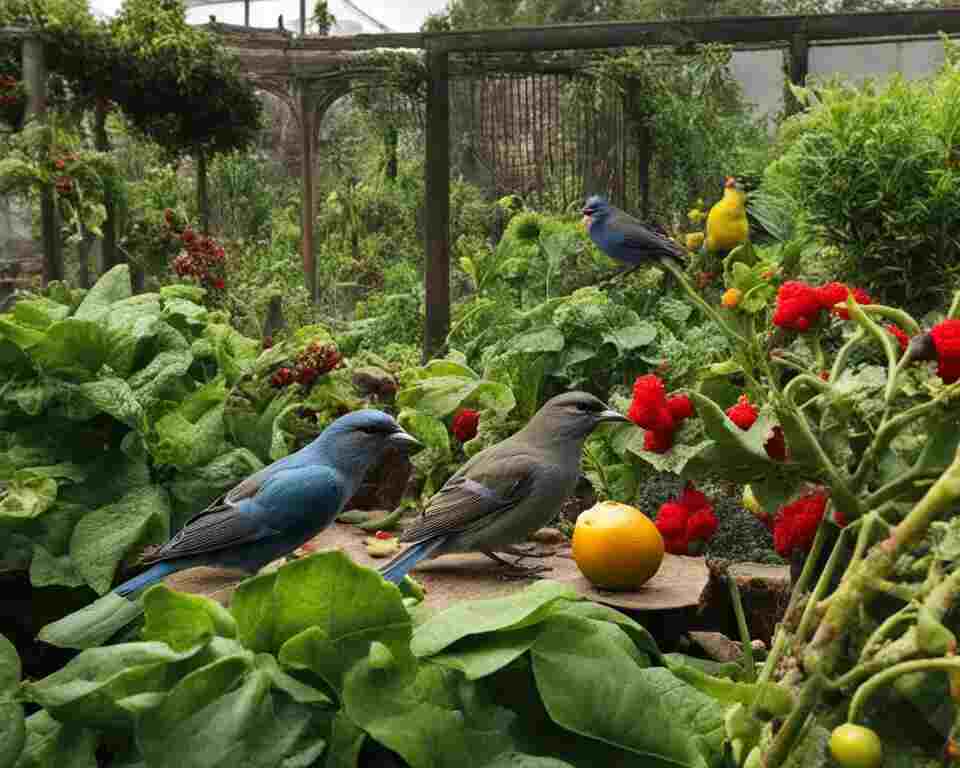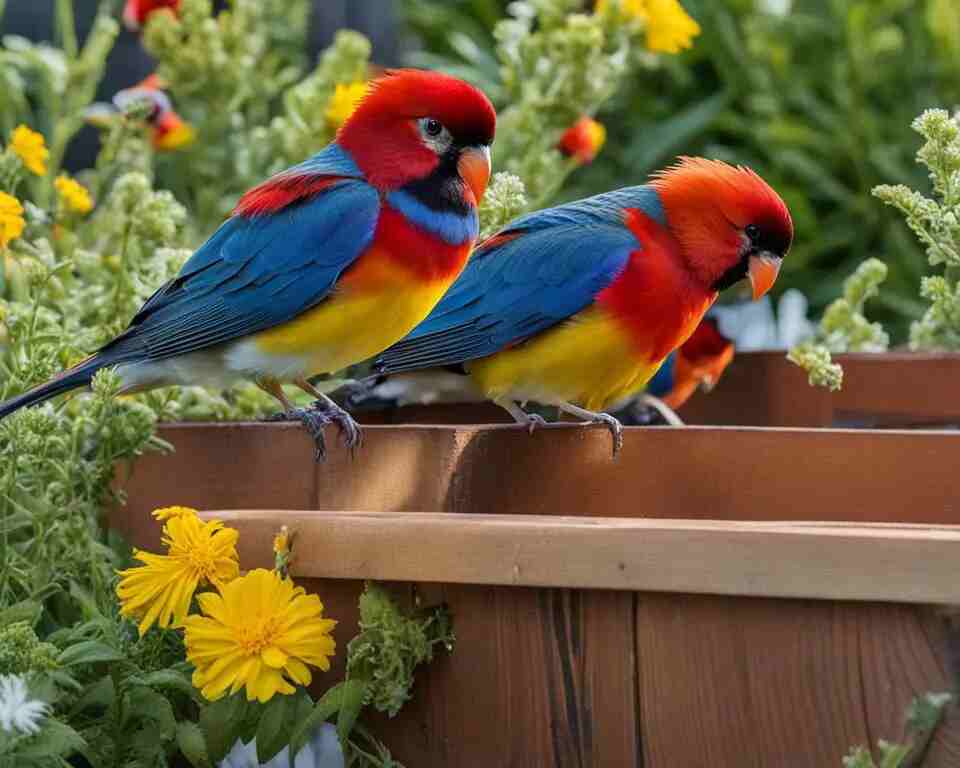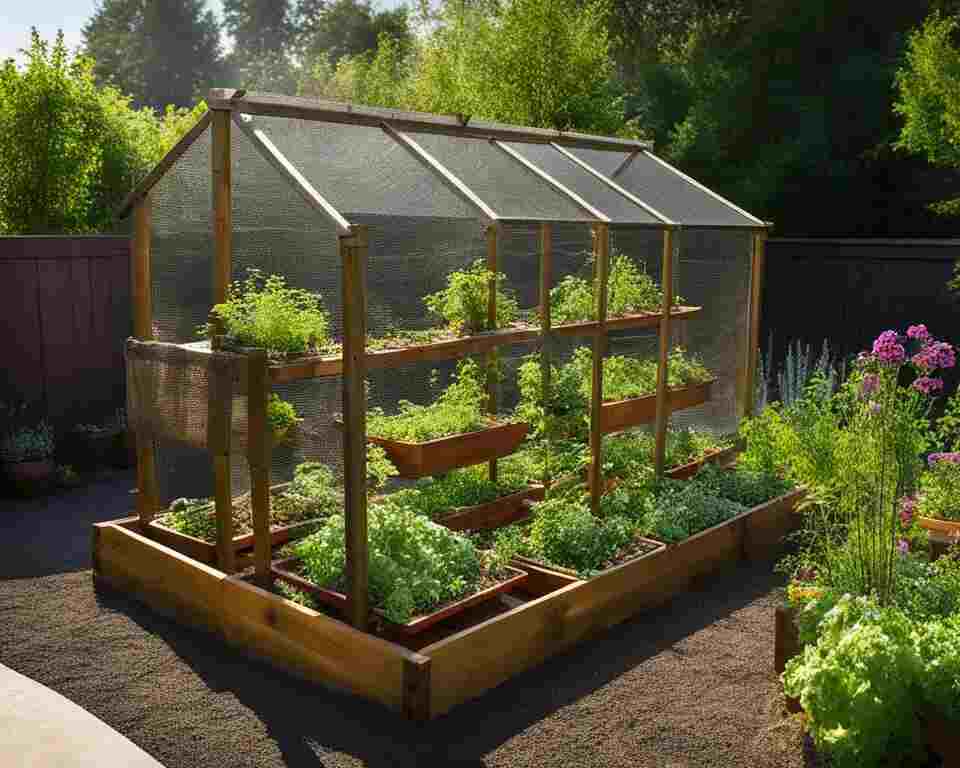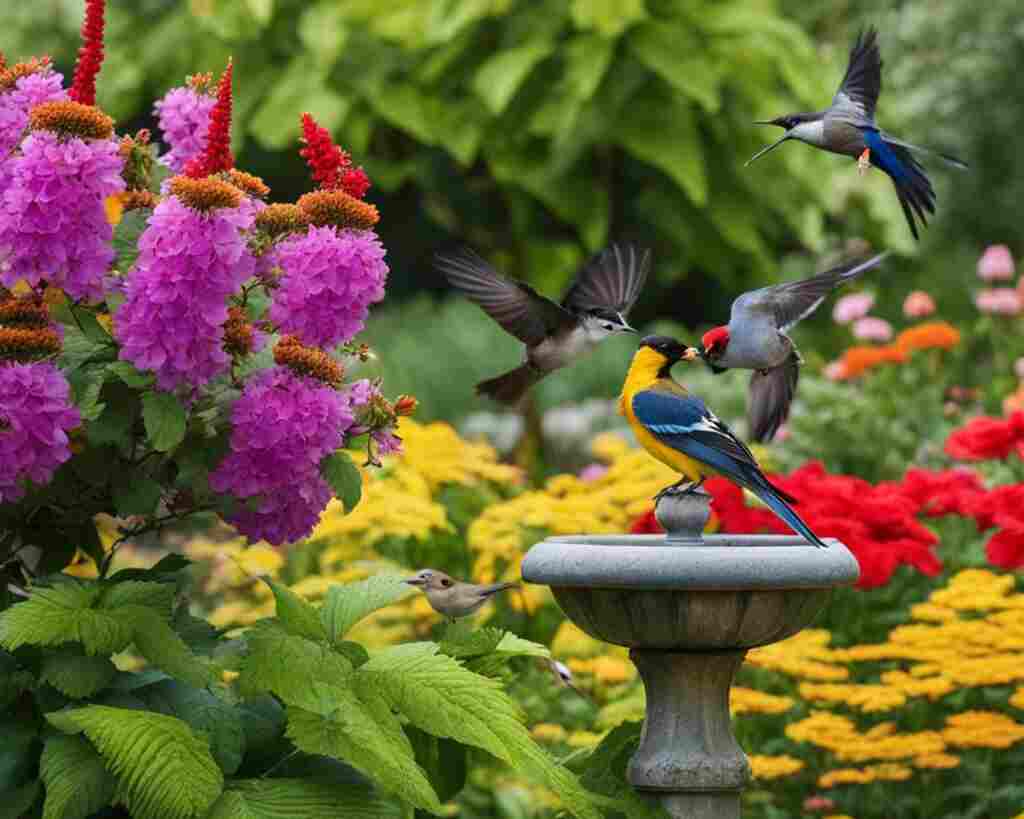As a gardener, I often find myself pondering the presence of birds in my garden. Are they beneficial allies or potential threats? Birds have a complex role in gardens, with both positive and negative impacts.
While some species offer pest control and weed control benefits, others can cause damage to crops and lawns. It’s important to understand the dual nature of garden birds and find strategies to mitigate any potential harm they may cause.
Table of Contents
- 1 Key Takeaways:
- 2 Are Birds Bad for Gardens?
- 3 The Dual Nature of Garden Birds
- 4 Understanding Bird Behavior in the Garden
- 5 Bird Species That Benefit Your Garden
- 6 Assessing the Damage: How Birds Affect Gardens?
- 7 Tailored Strategies to Deter Unwanted Bird Species
- 8 Exclusion Methods to Protect Your Garden from Birds
- 9 Birds You Might Consider Deterring
- 10 DIY Solutions to Shield Your Seedlings
- 11 Employing Natural Tactics for Bird Control
- 12 Adapting Your Garden to Coexist with Birds
- 13 Conclusion
- 14 FAQs:
- 14.1 What benefits do birds provide to gardens?
- 14.2 How do birds cause damage to gardens?
- 14.3 What can I do to deter birds from my garden?
- 14.4 What should I do to protect my seedlings from bird damage?
- 14.5 Can I employ natural tactics for bird control?
- 14.6 How can I create a bird-friendly yet crop-safe environment in my garden?
- 15 Source Links
- 16 Author
Key Takeaways:
- Birds play a dual role in gardens, with both positive and negative impacts.
- Some birds provide valuable pest control and weed control benefits.
- Certain bird species can cause damage to crops and lawns.
- Understanding bird behavior and preferences is crucial in managing their impact on gardens.
- Implementing tailored strategies and exclusion methods can help protect gardens from bird damage.

Are Birds Bad for Gardens?
Birds in gardens can be both beneficial and challenging. They contribute to natural pest control and pollination, aiding plant health. However, some birds may consume seeds or damage crops.
Striking a balance by providing bird-friendly elements like feeders while protecting vulnerable plants helps create a harmonious coexistence between birds and gardens.
The Dual Nature of Garden Birds
Garden birds play a significant role in the overall ecosystem of a garden. On one hand, they offer several benefits, such as pest control and weed management. However, certain bird species can also pose a challenge by feasting on crops and lawns.
It is important to understand both the positive and negative impacts of birds in gardens to maintain a harmonious balance.
The Benefits of Birds in Gardens: Pest and Weed Control
Birds are nature’s natural pest controllers and play a crucial role in reducing garden pests. They have a voracious appetite for harmful insects, larvae, and garden pests that can damage plants and crops. Additionally, some bird species also consume weed seeds, contributing to weed control in gardens.
By relying on birds for pest and weed control, gardeners can reduce the need for chemical insecticides and herbicides, creating a healthier and more eco-friendly garden environment.
The Downside: Birds Feasting on Crops and Lawns
While birds offer many benefits, certain species can become a nuisance when they start feasting on crops and lawns. Fruits, vegetables, and newly sprouted plants are particularly vulnerable to bird damage. Birds can peck at ripe fruits, causing significant loss, and can uproot newly planted seedlings.
Lawns may also suffer as birds dig up the grass in search of insects or worms. To prevent excessive damage, it is crucial to implement effective bird deterrent strategies and protect vulnerable areas of the garden.
Understanding Bird Behavior in the Garden
Understanding bird behavior is crucial in managing their impact on gardens. Different bird species have seasonal feeding patterns, and their preferences for food can vary. Additionally, the availability of native food supply plays a significant role in determining bird habits and foraging behaviors in gardens.
Seasonal Feeding Patterns of Garden Birds
Garden birds exhibit distinct feeding patterns throughout the year. In spring and summer, when insects are abundant, birds rely heavily on insects and other invertebrates as a food source. They actively forage for worms, grubs, and caterpillars to feed their young.
During the fall, as insect populations decrease, birds shift their diet towards seeds, berries, and fruits to prepare for migration or to survive the winter. Understanding these seasonal feeding patterns can help gardeners provide appropriate food sources to attract and support birds in their gardens.
The Significance of Native Food Supply on Bird Habits
The availability of native plants and their associated fruits, seeds, and nectar plays a crucial role in shaping bird behaviors in gardens. Native plants provide birds with a familiar and nutritious food supply that meets their specific dietary needs.
By incorporating a variety of native plants into a garden, gardeners can create a rich and diverse habitat that attracts a wide range of bird species. These native food sources not only benefit birds but also contribute to the overall health and sustainability of the garden ecosystem.

Bird Species That Benefit Your Garden
Some bird species offer specific benefits to gardens.
Bluebirds, jays, cardinals, swallows, thrashers, warblers, flycatchers, robins, martins, and other natural pest controllers help control garden pests, while certain birds act as pollinators, contributing to the growth and bloom of plants.
Understanding the roles of different bird species can help gardeners attract beneficial birds and enhance their garden’s health.
Natural Pest Controllers: Bluebirds, Cardinals, and More
Bluebirds and cardinals are not only beautiful to observe but also play a critical role in controlling garden pests. These species, along with others such as chickadees and wrens, feed on insects and help naturally regulate their populations.
By attracting these natural pest controllers to your garden, you can reduce the need for chemical pesticides and promote a healthier ecosystem.
Pollinators and Bloom Boosters: The Role of Birds
In addition to pest control, certain bird species act as essential pollinators, facilitating the reproduction and growth of plants.
This process contributes to the fertilization of plants and promotes their blooming and fruit production.
| Bird | Benefit |
|---|---|
| Bluebirds | Natural pest control by feeding on insects harmful to gardens |
| Cardinals | Assist in pest control and seed dispersion |
| Hummingbirds | Pollinate flowers and contribute to their growth and bloom |
By understanding the roles of these and other beneficial bird species, gardeners can create an environment that attracts and supports these helpful creatures.
Implementing practices to attract natural pest controllers and pollinators can lead to a healthier garden with reduced reliance on pesticides and increased plant productivity.
Assessing the Damage: How Birds Affect Gardens?
When it comes to gardens, birds can have both positive and negative effects. While they contribute to pest control and weed control by feasting on harmful insects and weed seeds, they can also cause damage by eating plants and fruits.
It is important for gardeners to assess the extent of bird damage in order to determine the severity of the issue and implement appropriate bird control strategies.

Tailored Strategies to Deter Unwanted Bird Species
Implementing tailored strategies to deter unwanted bird species can help protect gardens. There are various methods available, including visual scare tactics and the use of noisemakers.
Repelling Birds with Visual Scare Tactics
Visual scare tactics can be effective in deterring birds from approaching gardens. By hanging reflective objects, such as CDs or aluminum foil strips, birds can be discouraged from landing and causing damage.
Replicas of predator birds, such as owls or hawks, can also be placed strategically to create a sense of danger for unwelcome bird species.
Noisemakers: Do They Work Long-Term?
Noisemakers can be used to create a deterrent effect and discourage birds from lingering in the garden. The sound of radios tuned to talk stations or intermittent canon exploders can make birds feel uneasy and prompt them to seek quieter areas.
However, it is crucial to rotate the use of noisemakers regularly to prevent birds from becoming accustomed to the sound and ignoring the deterrent effect.
| Pros | Cons |
|---|---|
| Can be visually appealing in the garden | Effectiveness may vary depending on the bird species |
| Relatively easy to implement | May require regular repositioning or replacement to maintain effectiveness |
| Can provide a non-lethal solution to deter birds | May only work as a temporary solution |
Exclusion Methods to Protect Your Garden from Birds
How to Properly Use Bird Netting
One effective method of bird control for gardens is the proper use of bird netting. Bird netting is a physical barrier that prevents birds from accessing crops and fruits. It is essential to use bird netting correctly to maximize its effectiveness.
To properly use bird netting, follow these steps:
- Cover the entire garden area with bird netting, ensuring that there are no gaps or openings where birds can enter.
- Secure the netting firmly to the ground using stakes or weights to prevent birds from lifting it and gaining access to the garden.
- Regularly check the netting for any damages or holes and repair or replace it as needed to maintain its efficacy.
By utilizing bird netting, gardeners can create a physical barrier that effectively deters birds and protects their crops and fruits from damage.
Alternative Barriers: Garden Fabric, Crop Cages, and Other Ideas
In addition to bird netting, there are various alternative barriers that gardeners can employ to prevent bird damage. These alternative barriers provide additional options for garden protection:
- Garden fabric: This lightweight fabric can be draped over plants and secured in place to create a barrier that prevents birds from reaching them.
- Crop cages: These structures, typically made from wire mesh, enclose specific areas of the garden, shielding crops from bird access.
- Other creative ideas: Some gardeners have found success in deterring birds by using scarecrows, reflective surfaces, or special bird repellents.

Implementing alternative barriers alongside bird netting can provide extra layers of protection against bird damage and ensure the preservation of a thriving garden.
Birds You Might Consider Deterring
The Impact of Blackbirds, Crows, and Other Pests on Your Garden
Certain bird species, such as blackbirds, crows, and other pests, can cause significant damage to gardens. Their feeding habits and foraging behaviors can result in the destruction of crops, fruits, and vegetables.
Apart from the physical damage they cause, these birds can also attract other pests and create an imbalance in the garden ecosystem.
Understanding Which Birds to Attract and Which to Repel
While birds can be beneficial to gardens, it is crucial to identify which species to attract and which to repel. Attracting the right birds, such as natural pest controllers and pollinators, can help maintain a balanced ecosystem and enhance garden health.
On the other hand, deterring bird pests can protect crops and prevent further damage. Implementing bird repellent strategies, such as visual scare tactics or noisemakers, can help discourage unwanted birds from entering the garden.
DIY Solutions to Shield Your Seedlings
Protecting your seedlings from bird damage is crucial to ensure successful garden growth. Fortunately, there are several DIY solutions that you can implement using household items to keep birds at bay.
These inexpensive and creative methods can effectively safeguard your seedlings and prevent them from becoming a target of bird attacks.
Using Household Items for Garden Protection
One simple and cost-effective way to protect your seedlings is by using household items that you may already have on hand. For instance, disposable cups can be repurposed as individual seedling guards. Cut the bottom of each cup and carefully place it over the young plant, creating a physical barrier that prevents birds from reaching the delicate leaves and stems.
Another option is to repurpose inverted crates, such as milk crates or wooden crates, as seedling covers. By turning the crates upside down and placing them over your seedlings, you create a protective shield that discourages birds from accessing your plants. Ensure that the gaps between the crate slats are small enough to prevent birds from squeezing through.
Additionally, you can use reflective objects strategically placed near your seedlings to deter birds. Birds are often startled by reflective surfaces, so consider hanging CD discs or aluminum foil strips around your garden to create a visually disruptive environment that discourages birds from landing and pecking at your seedlings.
Installing Chicken Wire and Other Physical Barriers
For a more long-term solution, installing chicken wire or other physical barriers can effectively shield your seedlings from bird damage. Secure a layer of chicken wire around your garden bed to create a barrier that prevents birds from reaching the seedlings.
Be sure to bury the bottom edges of the chicken wire into the ground to discourage birds from digging or squeezing underneath.
If you have raised beds or containers, consider constructing frames covered with bird netting or mesh. These frames provide a sturdy structure that keeps birds away from your seedlings while allowing sunlight and rain to reach the plants.
Ensure that the netting or mesh is tightly secured to prevent birds from finding loopholes to access your precious seedlings.
Remember to regularly inspect and maintain these physical barriers to ensure their effectiveness. Birds are intelligent creatures that may attempt to find alternative ways to access your seedlings.
By consistently monitoring and reinforcing your physical barriers, you can ensure the optimal protection of your seedlings.
With these DIY solutions and effective physical barriers, you can safeguard your seedlings from bird damage and give them the best chance to flourish in your garden.
By preventing birds from targeting your young plants, you can enjoy a bountiful harvest and a thriving garden.
Employing Natural Tactics for Bird Control
When it comes to bird control in your garden, natural tactics can provide an environmentally friendly solution. By using homemade remedies and natural deterrents, you can discourage birds from damaging your plants without harming them or the ecosystem.
One effective homemade remedy is chili pepper spray. Birds have a strong aversion to the spicy taste of chili peppers, so spraying a mixture of water and chili pepper powder on your plants can deter them from feeding on them.
Another natural deterrent is reflective tape. The flashing light and movement of the tape mimic the presence of predators, making birds cautious and less likely to approach your garden. You can hang strips of reflective tape near your plants to create a visual deterrent.
Additionally, attracting predator birds to your garden can help naturally regulate bird populations. Birds of prey, such as owls or hawks, feed on smaller birds and rodents, which in turn reduces the number of birds damaging your plants. To attract predator birds, you can set up birdhouses or perching posts in strategic locations in your garden.
Homemade Remedies and Natural Deterrents
Homemade remedies and natural deterrents can effectively discourage birds from damaging plants in your garden. By harnessing the power of natural ingredients and visual deterrents, you can create an environment that is less attractive to birds.
Benefiting from the Ecosystem: Attracting Predator Birds
Attracting predator birds to your garden not only helps control populations of birds damaging plants, but also promotes a balanced ecosystem. By providing habitat and food sources for predator birds, you create a natural control system that keeps bird populations in check.
Adapting Your Garden to Coexist with Birds
Creating a Bird-Friendly Yet Crop-Safe Environment
Coexisting with birds in the garden involves creating a bird-friendly environment while safeguarding crops. By providing birdhouses or bird baths for nesting and watering, gardeners can attract and support bird populations.
These amenities not only create a welcoming habitat for birds but also encourage them to stay and establish their homes in the garden. Additionally, offering bird feeders stocked with food appropriate for local bird species can further enhance the bird-friendly environment.
It is crucial to ensure that the bird-friendly elements in the garden do not compromise the safety and productivity of the crops. Careful placement of birdhouses, feeders, and water sources should be done in a way that minimizes their proximity to vulnerable plants.
This reduces the chances of bird damage to crops while still providing the necessary resources for the birds’ well-being. Regular monitoring and maintenance of the bird-friendly elements in the garden are essential. Cleaning bird feeders and bird baths regularly helps maintain hygiene and prevent the spread of diseases.
Regularly inspecting and repairing birdhouses ensures they remain safe and functional for nesting birds. By creating a bird-friendly yet crop-safe environment, gardeners can strike a balance that benefits both the birds and the garden.
Plant Selection and Placement to Reduce Bird Damage
The selection and placement of plants play a significant role in minimizing bird damage in gardens. In areas where birds cause significant harm, gardeners can consider choosing plants that birds are less likely to eat. This includes selecting plant varieties with naturally strong scents or unpalatable tastes to deter birds from feeding on them.
Separating vulnerable plants from bird attractants can also help reduce bird damage. Placing feeders or birdbaths away from areas with high-value crops can divert bird activity away from those plants. Creating physical barriers, such as fences or trellises, can further protect plants from direct bird access.
When planning the layout of the garden, integrating diversity is key. Mixing different types of plants, including those that birds find less appealing, encourages biodiversity and can reduce the concentration of bird damage.
Additionally, providing alternative food sources, such as planting fruit-bearing shrubs or trees away from the main garden, can redirect bird attention and minimize the impact on the cultivated crops.
Bird-Friendly Garden Tips
Implementing bird-friendly garden tips can promote harmony between birds and the garden. Here are some strategies to consider:
- Choose native plants that provide food and shelter for birds.
- Plant a variety of flowering plants to attract a diverse range of bird species.
- Avoid using pesticides and herbicides that can be harmful to birds.
- Install reflective bird deterrents, such as aluminum foil strips or wind chimes, to discourage birds from landing on vulnerable plants.
- Prune trees and shrubs to create dense foliage for bird nesting and roosting.
- Provide a water source, such as a birdbath or shallow dish, for birds to drink and bathe.
- Remove bird-attracting features, such as excess fruit or seeds, during periods of high vulnerability for crops.
- Regularly clean feeders and birdhouses to maintain their attractiveness and safety.
By implementing these bird-friendly garden tips, gardeners can foster a thriving ecosystem that supports both the beauty of nature and the productivity of the garden.
Conclusion
In conclusion, birds play a crucial role in gardens, with both positive and negative impacts. While some birds provide valuable benefits by controlling pests and weeds, others may cause damage to crops and lawns. It is important for gardeners to understand the role of birds in their gardens to effectively manage and minimize any negative impact.
By implementing appropriate strategies for bird control, gardeners can create a balanced environment that fosters a healthy and thriving garden. This may include using visual scare tactics, noisemakers, or physical barriers like bird netting to deter unwanted bird species.
Bird-friendly gardening tips, such as attracting pollinators and native food sources, can also help create a harmonious relationship between birds and the garden.
Preventing bird damage in gardens requires a proactive approach and an understanding of bird behavior. Assessing the extent of bird damage, identifying which birds to attract or repel, and implementing tailored solutions can make a significant difference.
By incorporating these strategies, gardeners can minimize the negative impact of birds while promoting a flourishing garden ecosystem.
FAQs:
What benefits do birds provide to gardens?
Certain bird species help control garden pests and act as natural pest controllers. They also contribute to weed control in gardens. Additionally, some birds act as pollinators, promoting the growth and bloom of plants.
How do birds cause damage to gardens?
While birds can be beneficial, certain species can feast on crops and lawns, causing damage to fruits, vegetables, and grass. It is important to strike a balance and implement strategies to deter unwanted bird species while attracting beneficial ones.
What can I do to deter birds from my garden?
There are several strategies you can employ to deter birds from your garden. Visual scare tactics, like hanging reflective objects or replicas of predator birds, can discourage birds from approaching. Noisemakers, such as radios or intermittent canon exploders, may also be effective.
Additionally, implementing exclusion methods like bird netting, garden fabric, and crop cages can physically prevent birds from accessing your crops and fruits.
What should I do to protect my seedlings from bird damage?
To prevent bird damage to your seedlings, you can use DIY solutions like using disposable cups or inverted crates to shield them. Installing chicken wire or other physical barriers can also provide long-term protection against bird attacks.
Can I employ natural tactics for bird control?
Yes, natural tactics for bird control can be employed. Homemade remedies and natural deterrents, such as chili pepper spray or reflective tape, can discourage birds from damaging plants. Additionally, attracting predator birds, like owls or hawks, can help naturally regulate bird populations in the garden.
How can I create a bird-friendly yet crop-safe environment in my garden?
Creating a bird-friendly environment in your garden involves providing birdhouses or bird baths for nesting and watering. Selecting plants and their placement strategically can also help reduce bird damage. By implementing bird-friendly garden tips, you can promote harmony between birds and your garden while safeguarding your crops.
Source Links
- https://www.gardeners.com/how-to/birds/5237.html#:~:text=Many birds are friends to,we categorize them as pests.
- https://www.budget101.com/gardening-landscaping/580969-birds-in-the-garden-which-to-attract-or-deter/
- https://www.farmanddairy.com/top-stories/how-to-protect-your-garden-from-birds/261544.html


